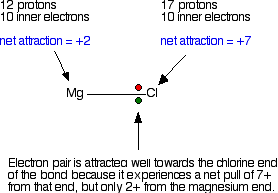
Group 2 Electronegativity
 المؤلف:
........
المؤلف:
........
 المصدر:
LibreTexts Project
المصدر:
LibreTexts Project
 الجزء والصفحة:
............
الجزء والصفحة:
............
 30-3-2019
30-3-2019
 1903
1903
Group 2 Electronegativity
Electronegativity is a measure of the tendency of an atom to attract a bonding pair of electrons. It is usually measured on the Pauling scale, on which the most electronegative element (fluorine) is assigned an electronegativity of 4.0.

Each of these elements has a low electronegativity on the Pauling scale, and the electronegativities clearly decrease down the group. The atoms are decreasingly effective at attracting bonding pairs of electrons. Imagine a bond between a magnesium atom and a chlorine atom. The bond can be considered covalent at first, consisting of a pair of shared electrons. The electron pair is pulled toward the chlorine atom because there is a much greater net pull from the chlorine nucleus than from that of magnesium.

At this point, the electrons are so close to the chlorine that there is essentially a transfer of an electron to the chlorine; in other words, ions are formed. The strong attractive force from the chlorine nucleus makes chlorine much more electronegative than magnesium. This result can be compared with a beryllium-chlorine bond. The net pull from each end of the bond is the same as before, but the beryllium atom is smaller than a magnesium atom; consequently, the electron pair is closer to the net +2 charge from the beryllium end, and is more strongly attracted.

In this case, the electron pair is not close enough to the chlorine for an ionic bond to be formed. Because of its small size, beryllium forms covalent bonds, not ionic bonds. The attraction between the beryllium nucleus and a bonding pair is always too great for ionic bonding.
 الاكثر قراءة في الجدول الدوري وخواص العناصر
الاكثر قراءة في الجدول الدوري وخواص العناصر
 اخر الاخبار
اخر الاخبار
اخبار العتبة العباسية المقدسة


